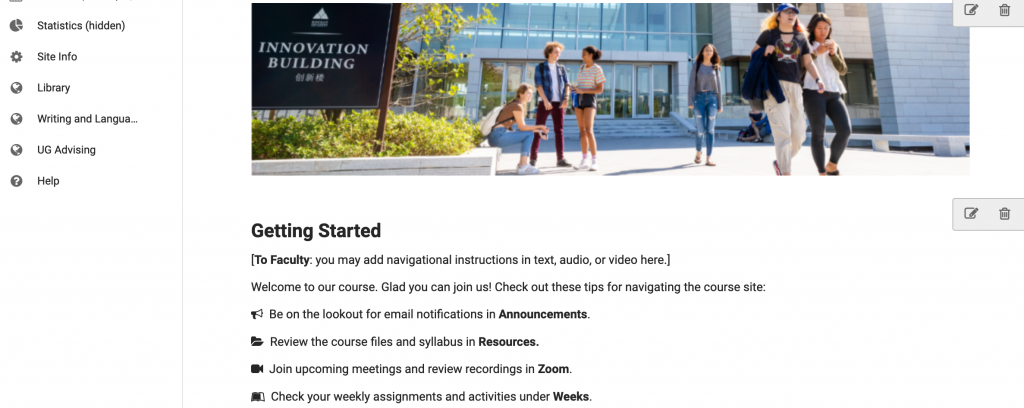This guide will help you successfully finish Session 4.
Online learning requires faculty and students to teach and to learn with intentionality and focus. From lectures to labs, your faculty have been scrutinizing every aspect of their teaching to deliver a quality online educational experience. But they can only do so much. You, too, have a chance to create a uniquely rich learning environment.
Already, DKU has been featured globally for its two week transition to online learning and we have just released Four Weeks In: 10 Lessons from Teaching Online at Duke Kunshan University. We invite you to join the faculty in writing the next chapter in DKU’s global leadership.
Below you’ll find a checklist of essential practices for online learning, specific strategies for synchronous and asynchronous environments and a special section on group work.
Essential Practices
☐ Communicate with your instructor early and often. Let your teachers know how the course is going without overwhelming them. Make your comments suggestions and offer to problem-solve. Check your DKU email at least twice a day.
☐ Set aside time free from distractions (including unnecessary open tabs in your web browser) to participate in class and complete assignments, and having a dedicated work space. Note that this may require communicating with other household members about what you need to be successful.
☐ Set reminders, either through an online calendar or phone app, about class meeting times and course due dates.
☐ Create study groups. Reach out to students who aren’t in the same time zone and may need to connect with you asynchronously. Look for or suggest a forum where students can post the times they are available (or their time zones) and their own Zoom link so they can virtually get together. Arrange your own peer-to-peer asynchronous and synchronous conversations.
Synchronous Strategies
☐ Use your video camera unless your bandwidth is poor. (Otherwise it’s too easy to check out.) If possible, plug in a phone or other headset with a built-in microphone, rather than your laptop’s speakers and microphone. Do your best to be in a quiet location. Mute your microphone when not speaking.
☐ Zoom has the ability to provide live closed captioning. If you are not seeing this, and would like to see this feature enabled, please feel free to reach out to your instructor.
☐ Use the chat function and encourage your peers to respond to each other. Be aware of how much you are contributing to in-class discussions. Try not to silence yourself out of concern for what others will think about what you say. If you have a tendency to contribute often, give others the opportunity to speak. If you tend to stay quiet, challenge yourself to share ideas so others can learn from you.
Asynchronous Strategies
☐ Communicate early and often with your instructors, especially if you have questions about the material, have difficulty finding or accessing course materials, or simply feel unsure how best to engage.
☐ Use video or pictures of yourself in Forum posts and online sessions so that other students can see you and know you are engaged.
☐ When prompted, engage in the Sakai discussion forums with thoughtful, substantive responses to course readings, your peers’ comments, and to ask/answer questions.
☐ Independently, or with the help of your instructor, find ways to engage with your peers. This might include live discussions using Zoom, breakout rooms for smaller group interactions, or taking advantage of the chat function when appropriate.
☐ Re-read and think before you post in online discussions, since intentions behind a statement might not be clear.
Group Work
☐ Make regular progress, even if small, and stay in touch. Consider a quick text on your group chat about progress every couple of days. Ideally, have real conversations over video every week you’re working together.
☐ Set a purpose for meetings in advance and use a shared note document so you can all contribute and follow along.
☐ Check on each other and ask for backup: If someone has been absent from your group meetings or chat, ask them directly if they’re still able to participate in the project. If you aren’t getting responses within a day or two, let your instructor know. Know it isn’t being petty, it’s your team’s responsibility.
Need help?
☐ Get in touch with your instructors and advisors.
☐ For resources and answers to frequently asked questions, visit Online Student Learning Sakai site The resources and discussion forums on this Sakai site are designed to help you transition to the online format and answer any questions you might have related to courses or technology. For all technical problems, contact the IT Help Desk at service-desk@dukekunshan.edu.cn.
☐ If you need a learning consultation or a tutor, the Academic Resource Center is available to you online.
☐ For technical help with Sakai, Zoom, or VPN, contact:
- China-based faculty/staff/students (+86) 0512- 3665-7100
- US-based faculty/staff/students (+1) 919-660-1810
- International-based faculty/staff/students can use either telephone option (recommend using tools like Skype calling)
- Live Chat: https://oit.duke.edu/help
- Email: service-desk@dukekunshan.edu.cn
Credits
Adapted from the University of Michigan Center for Research on Learning and Teaching (http://www.crlt.umich.edu/examples-discussion-guidelines) and the Columbia Center for Teaching and Learning (https://ctl.columbia.edu).


